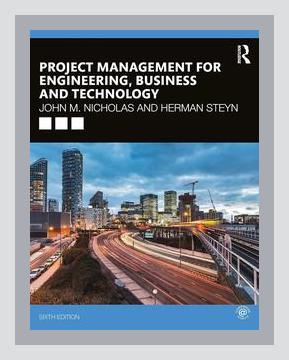Operations and Supply Chain ManagementProject Management
**
1. Introduction to Project Management
Overview:
The book begins by establishing the importance of project management in today’s complex and competitive global market. It defines a project as a temporary endeavor undertaken to create a unique product, service, or result.
Actionable Step:
Understand and articulate the importance of project management in your organization’s strategic goals. Identify a specific upcoming project and outline its uniqueness and temporary nature.
Example:
The book details an example from the aerospace industry where a project often involves designing and launching a new satellite. The uniqueness is evident as every satellite is designed for specific needs and orbits.
2. Project Life Cycle and Organization
Overview:
Projects follow a life cycle that includes initiation, planning, execution, monitoring and controlling, and closure.
Actionable Step:
Map out the life cycle stages for your project. Ensure you have clear deliverables and transitions for each phase.
Example:
In software development, the ‘initiation’ phase might involve feasibility studies and requirement gathering, while ‘closure’ might include final testing and user training.
3. Project Selection and Portfolio Management
Overview:
Project selection involves comparing the potential benefits and costs of different projects to determine which ones to pursue. Portfolio management ensures that selected projects align with the strategic goals of the organization.
Actionable Step:
Develop a clear set of criteria for project selection, including alignment with organizational strategy, expected ROI, and risk assessment.
Example:
A manufacturing company may use a weighted scoring model to evaluate potential projects, where criteria like cost, market potential, and technological feasibility are scored to make an informed decision.
4. Project Planning and Scheduling
Overview:
Effective project planning and scheduling are crucial to project success. Tools such as Gantt charts, Critical Path Method (CPM), and Program Evaluation and Review Technique (PERT) are discussed.
Actionable Step:
Utilize software tools to create a detailed project schedule. Identify the critical path and develop contingency plans for potential delays.
Example:
A construction project might use a Gantt chart to detail all tasks and their durations, ensuring that dependencies are clearly mapped and adjusted as needed.
5. Resource Allocation
Overview:
Resource allocation involves ensuring that the necessary human, financial, and material resources are available when needed. This section emphasizes the importance of resource leveling and optimization.
Actionable Step:
Conduct a resource audit for your project and create a resource allocation plan that anticipates future resource needs and potential bottlenecks.
Example:
In a healthcare project, scheduling specialist doctors and medical equipment in advance can prevent scheduling conflicts and ensure smooth operations.
6. Risk Management
Overview:
Risk management encompasses the identification, analysis, response planning, and monitoring of risks. The book outlines strategies like risk avoidance, mitigation, transfer, and acceptance.
Actionable Step:
Create a risk management plan for your project that includes a risk register. Identify potential risks, their impact, and mitigation strategies.
Example:
For an IT project, a common risk might be data breaches. Mitigation strategies could include robust data encryption and regular security audits.
7. Cost Estimation and Budgeting
Overview:
Accurate cost estimation and budgeting are critical to maintaining financial control. Techniques include analogous estimation, parametric estimation, and bottom-up estimation.
Actionable Step:
Develop a comprehensive budget for your project using a combination of estimation techniques. Monitor expenses regularly to stay within budget.
Example:
In civil engineering, a detailed bottom-up estimation might involve calculating the costs of raw materials, labor, and machinery, aggregating them to form an overall project budget.
8. Project Execution
Overview:
Execution is where project plans are put into action. Effective leadership, communication, and stakeholder engagement are necessary for success.
Actionable Step:
Implement a communication plan to keep all stakeholders informed. Hold regular progress meetings and adjust plans as necessary.
Example:
In a marketing project, execution could involve launching a new advertising campaign where different media outputs are disseminated according to a strict schedule.
9. Project Monitoring and Controlling
Overview:
This phase focuses on tracking project progress and performance to ensure that everything stays on track. Techniques include Earned Value Management (EVM) and Key Performance Indicators (KPIs).
Actionable Step:
Set up a system to monitor key performance metrics. Use EVM to correlate project reports with cost accounting to identify variances early.
Example:
In a telecommunications project, regular KPI reviews might include metrics like network uptime and user satisfaction rates.
10. Project Closure
Overview:
Project closure involves finalizing all project activities, delivering the project output to the client, and closing out contracts. A post-project review is also necessary for identifying lessons learned.
Actionable Step:
Develop a closure plan detailing final deliverables, stakeholder sign-offs, and a lessons learned document for future projects.
Example:
In an event management project, closure would involve delivering the event report to the client, settling final invoices, and conducting a post-event debrief.
11. Technical, Agile, and International Project Management
Overview:
The book also touches on specialized forms of project management, including technical projects, Agile methodologies, and international project management. Agile principles focus on adaptability and customer collaboration, while international projects require cross-cultural management.
Actionable Step:
For technical projects, ensure rigorous requirement gathering and frequent testing. For Agile projects, hold regular sprints and reflect on feedback. For international projects, engage in cross-cultural training.
Example:
A multinational IT project might use Scrum for its Agile approach, with sprints focusing on incremental software releases, and employ cross-cultural communication strategies.
Conclusion:
“Project Management for Engineering, Business and Technology” provides a comprehensive guide for managing projects across various domains. By following the structured approaches and leveraging concrete tools and techniques discussed in the book, project managers can significantly enhance their project outcomes.
This structured summary captures the essence of the book while offering practical steps and examples to apply its principles effectively.
